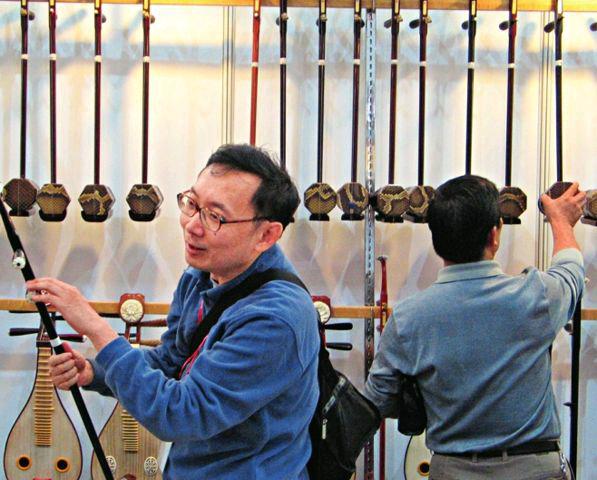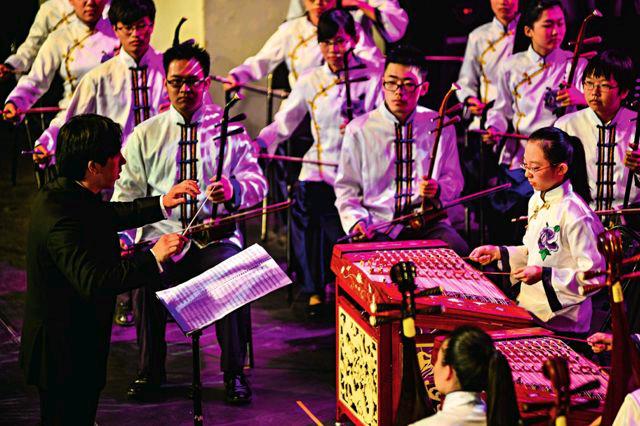Carry on the Tradition of Chinese Music
By+staff+reporter+LI+YUAN
ON a freezing Saturday morning, nine-year-old Tongtong and her mother made their way to flute class at the Orange Tree, an art training company in central Beijing. She has attended it every week for over a year, and has never missed a lesson.
As the gale howled outside, the training center filled with students preparing for their music classes.
Traditional Musical Instruments: a New Trend
When the Orange Tree was founded in 2011, traditional Chinese instruments were not part of the curriculum. Instead it offered classes in singing and Western instruments. As more and more parents requested classes in Chinese instru- ments, the company opened courses on the zheng (zither), pipa, erhu, flutes, hulusi (gourd lute) and bawu.
“The fever for Chinese instruments runs high these days,” said Zhang Shuang, a graduate of the Chinese Instruments Department of the China Conservatory, who teaches flute and is also headmas- ter of the Orange Trees World Towers branch. She teaches five to six classes per day on weekends.
The students come from all age groups, from preteens to whitecollar workers and pensioners. “Children normally choose weekend classes, while adults fill the slots from Monday to Friday,” Zhang said.
According to statistics from the China National Orchestral Music Society, more than one million Chinese minors studied the zheng over the past decade, 600,000 studied the erhu, 500,000 learned the yangqin and 400, 000 learned the flute.
Following the rise of musical training schools are an increase in amateur players clubs. Liu Xiaogang, aged 25,opened a musical instruments shop in Beijing after graduating from the Drama Institute of Shanxi Province. During a visit to a local park he met a group of retirees who taught themselves to play hulusi. He stepped in to offer advice, and became their volunteer teacher. Later Liu opened a free class in his neighborhood, which attracted more than 100 people within a year. The seniors in his class said learning an instrument enriched their lives and lifted their spirits.
The revival of folk music and instruments has generated plenty of business opportunities. At Lius shop the erhu, zheng, pipa and flute all sell well, with annual sales growing at 20 percent for three successive years.
Even lesser-known instruments like the yueqin, liuqin and ruan have found more students, as is demonstrated by the climbing sales of such stores as Shanghai Dunhuang Musical Instruments Co., Ltd. At a trade exhibition in 2014 the company sold two dozen guqin made of cedar wood, each priced at RMB 2,000, in a single day.endprint
Another sign of the trend is the strong popularity of classical music performances. In a single year, the China National Orchestra staged 170 commercial performances, earning RMB 13 million in total revenues, double the average of previous years.
The Propellers
“Primarily, it is to help the child develop a hobby,” Tongtongs mother Ms. Liu explained. While her daughter is in class, she waits in the lounge with other parents. Since wind instruments require strong lungs, Ms. Liu enrolled her daughter in a swimming class.
In many Chinese cities classical music has become part of the school curriculum. Many schools have their own orchestras and invite professional groups to perform. Winning prizes from regional and national competitions can add points to middle school entrance exams, a strong motivation for young learners.
As an adult, Zhang Shuang thinks that motivation is more about the desire to be artistically accomplished, and hence respected by peers. “National music is a buzzword today,” she said. “I have a 30-something male student who joined my flute class after seeing that all his friends had a skill to offer at parties. He doesnt want to be left out.”
The student added that like computer games, playing an instrument is also a way to socialize. Though he has only mastered a few simple melodies, the benefits are already emerging. His performance at a company party won the attention of many young ladies in the audience. He favored Chinese instruments because they are cheaper and easier to learn; a flute or hulusi costs only RMB 100, in contrast with Western instruments that often cost more than RMB 10,000.
The social climate is also conducive to the resurgence of traditional Chinese music, which Zhang says began with the 2008 Beijing Olympics. “The Olympic Games enabled the world to learn about China, and induced more exchanges that injected life into the domestic cultural market. Recognition from the outside world feeds our enthusiasm for traditional Chinese culture. The need for a richer culture, and a better livelihood, is another key factor,” Zhang said.
Her colleague Liu Caihua, a graduate of Tianjin Conservatory of Music, added another reason: the fanfare by the mass media. “I was first attracted to the erhu from watching TV. Its sound mesmerized me immediately,” he said.
China Central Television organized the first national musical instruments contest in 2007, and again in 2009 and 2012. “New forms and rhythms are presented to nationwide audiences, who learn to appreciate the charm of Chinese music. This rekindled public interest and improved its performance market. As traditional musicians, we have a lot of respect for the contest,” Liu said. The fourth contest is scheduled for 2015.endprint

The Ministry of Culture launched a program to develop and support Chinas folk music in 2011, and has since allotted RMB 6 million per year to that end. The effects are evident: “Thanks to support for Chinas folk music, we have encouraged many young and middleaged artists to study Chinese music over the past years,” said Xi Qiang, president of the China National Orchestra.
Sustaining the Trend
“Back in 2011, vocal students were 80 percent of the total. Now vocal and instrument classes are even, and folk instruments classes are still on the rise,”Zhang Shuang said. She cautioned that many applicants and their parents do not realize that Chinese instruments take a long time to learn and hone basic skills. Some parents expect quick results, and pull their kids out after a few days.
“Building receptivity is the first step to learning Chinese music, even before playing,” Zhang explained. “Only when one is able to understand music and knows its language can he learn how to play it.” This is why teachers at the Orange Tree offer programs individually tailored to each student, according to their personalities.
To enhance the quality of its teaching, the Orange Tree has innovated its curriculum, adding regular art salons and performances by faculty and students. A course on band management is also in the works. It is expected to give students firsthand knowledge and experience of each instruments role in an orchestra.
Some applicants are of preschool ages. According to Zhang Shuang, children usually try as long as they are interested. But different Chinese instruments have different physical requirements. For instance the zheng and pipa are both heavy and cannot be handled by children under six. And children cannot play wind instruments until they are at least eight years old.
To sustain the publics love for traditional Chinese music, Zhang Shuang believes that creation of relevant new works is vital. “All artworks are products of their times, and therefore cannot be altered arbitrarily. Thats why we should create works against the new historical backdrop, incorporating modern trends and speaking to the new generations.”
She explained the respective appeals of Chinese and Western music. Traditional Chinese music uses a pentatonic scale, compared with Western musics heptatonic scale. With five notes instead of seven, it is easier to learn. But, with a narrower range, it also has less diversity in composition. “Chinese and Western instruments can complement each other well, and produce wonderful effects when played in harmony,” Zhang said.endprint
This view is echoed by Liu Caihua, who agrees that the survival of traditional Chinese music depends on passing on traditions and introducing innovation. The repertoires of many orchestras have remained the same for decades, composed of a dozen classics including Er Quan Ying Yue (Moon Mirrored in the Pool), Gao Shan Liu Shui (Towering Mountain and Running Water) and Shi Mian Mai Fu (Ambush on All Sides). Audiences at home and abroad are getting bored and turning their backs on these well-known pieces.
But change is underway. In early 2014 a band of 26 players from Shang- hai Chinese Orchestra staged several performances in Spain and France, including Urgent Orders, Morning Fog and Ruins, which were all well received. After the performances were broadcast on French radio, many people called to ask for more contemporary productions of Chinese music.
As Wang Fujian, conductor and head of Shanghai Chinese Orchestra, sees it,“Chinese music will not truly establish its dignity until we have formulated a smooth, complete system, expanded the repertoire to include dozens or even hundreds of works, and cultivated a crop of musicians and fans.”endprint

